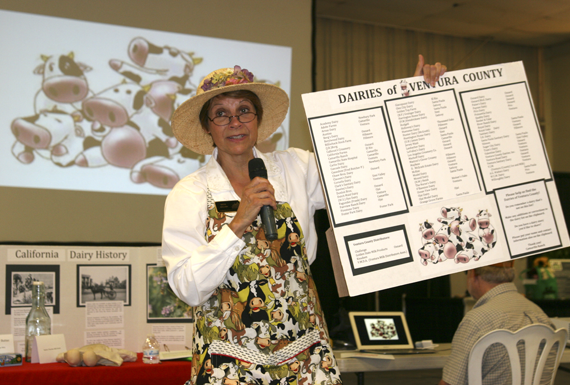
|
Visitors to the Ventura County Fair enjoyed a look back last Thursday when Beth Miller, a Camarillo House docent, presented a history of California’s Dairy farming. The Agriculture Building was the setting for the fun informative trip through time, from California and Ventura County’s early days to recent memory. Photos by Susan Branham |
Ventura County Fair
August 06, 2014
By Susan Branham
Santa Paula News
The Ventura County Fair is home to tradition, innovation, talent and fun. This year’s theme is, “A Country Fair with Ocean Air.” Visitors to the Agriculture and Natural Resources Building discover a collection of enticing activities, displays, and information ranging from cooking shows and trout feeding to seed planting, weaving and spinning to the Pinniped Fashion Show.
Last week, the Ag building was host to a program featuring the tradition and innovation of California’s dairy industry. Ventura County’s cool ocean air, an important gift to dairy farmers, swept through the fairgrounds Thursday as Beth Miller, a Camarillo House docent, recounted the fascinating history.
Her story extended from California’s early days to the years when early morning risers heard the rumble of the delivery truck and clinking of glass milk bottles on the front porch. She traced the history from the California Mission days, through the Gold Rush, and into recent memory.
The presentation was highlighted with slides and displays depicting Ventura County’s dairy history. Newspaper articles, photographs, and advertisements illustrated the evolution of the dairy industry. Retro milk bottles and a working cow bell were some of the fun reminders of days gone by.
Early missionaries depended on milk cows and their vegetable gardens, and as early as 1775, large herds were beginning to appear. Later, settlers expanded dairying. “Settlers came with the love of milk and cheese, and the family cow,” Beth explained. Those were the days when wagon travel over rough roads churned cream into butter.
Beth told how Ventura County’s dairy families - award-winning agricultural men and women and business people - worked together. Their success led to a remarkable chapter in the history of Ventura County.
Among the endeavors of the early dairies was the introduction of alfalfa crops from Chile. “It did well in California,” said Beth. “It was healthy for the cows and produced pleasant tasting milk.” She added that the crop is beneficial in replenishing the bee population.
Jean Bryan, the daughter of William Schwindt of Golden Top Farm, was in the audience enjoying the history of her family’s dairy. She remembers that families wanted home milk delivery before breakfast, especially in the days before refrigeration.
“Golden Top was known for the good rich cream at the top of the bottle,” Beth said. “Golden Top was always donating milk. They were community leaders.” The dairy made news in 1969 with the birth of the Golden Quads, “three heifers and one cantankerous little bull,” as they were called. “All four survived,” Beth added.
Adohr Farms, “The Home of Champions,” at one time boasted the world’s largest Guernsey herd. As with other Ventura County dairies, the cows were pampered. “The same worker milked the same cows at the same time every day,” Beth said.
At Billiwhack Stock Farm in Santa Paula’s Aliso Canyon, the cows enjoyed “what was considered the most efficient dairy in the state,” Beth said. In addition, the stalls featured tile and the ceilings were painted in a beautiful pattern.
“Does anyone remember the Chase Brothers Dairy tours?” Beth asked the audience. Several hands were raised. Former grade school students remember their favorite field trip day when they arrived at the dairy in yellow school buses and spent a fun day learning where and how their breakfast milk originated. “Tours of dairies were popular with children and adults and dairy science students,” Beth said.
Adolpho Camarillo and Joseph Lewis had a dairy on the Camarillo Ranch which produced an amazing 23,000 pounds of butter a month. Their story was featured in the Oxnard Daily Courier in 1903, complete with pictures of a real western round-up.
Sadly, Beth’s information display board tells us that these dairies, and many others, now exist only in the rich history of Ventura County.
Dairy families were attracted to Ventura County by the land and our famous weather, Beth explained. The families weren’t the only ones who enjoyed their surroundings. “Cows love a comfortable climate,” Beth said.



